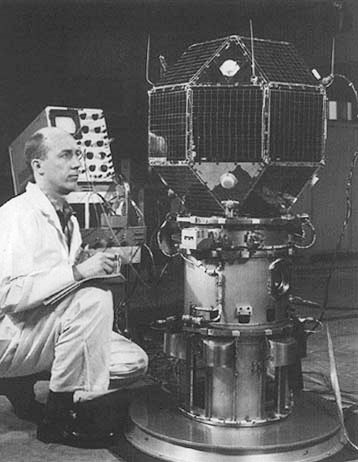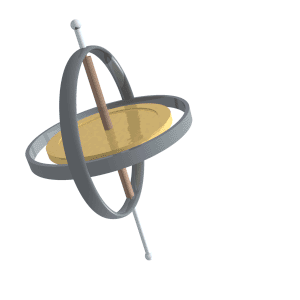|
LES-4
Lincoln Experimental Satellite 4, also known as LES-4, was a communications satellite, the fourth of nine in the Lincoln Experimental Satellite, and the first of the series designed for operations at geosynchronous altitudes. Launched by the United States Air Force (USAF) on 21 December 1965, it demonstrated many then-advanced technologies including active use of the military's SHF (super high frequency) band (7 to 8 GHz) to service hundreds of users. Background After the successful development and deployment of Project West Ford, a passive communications system consisting of orbiting copper needles, MIT's Lincoln Laboratory turned to improving active-satellite space communications. In particular, Lincoln aimed to increase the transmission capability of communications satellites ("downlink"), which was necessarily constrained by their limited size. After receiving a charter in 1963 to build and demonstrate military space communications, Lincoln focused on a number of engineer ... [...More Info...] [...Related Items...] OR: [Wikipedia] [Google] [Baidu] |
LES-3
Lincoln Experimental Satellite 3, also known as LES-3, was a communications satellite, the third of nine in the Lincoln Experimental Satellite. Launched by the United States Air Force (USAF) on 21 Dec 1965, it was stranded in a Geostationary Transfer Orbit rather than its planned circular high orbit. Despite this, LES-3 returned good data on communications propagation in the UHF band. Background After the successful development and deployment of Project West Ford, a passive communications system consisting of orbiting copper needles, MIT's Lincoln Laboratory turned to improving active-satellite space communications. In particular, Lincoln aimed to increase the transmission capability of communications satellites ("downlink"), which was necessarily constrained by their limited size. After receiving a charter in 1963 to build and demonstrate military space communications, Lincoln focused on a number of engineering solutions to the downlink problem including improved antennas, be ... [...More Info...] [...Related Items...] OR: [Wikipedia] [Google] [Baidu] |
Lincoln Experimental Satellite
The Lincoln Experimental Satellite series was designed and built by Lincoln Laboratory at Massachusetts Institute of Technology between 1965 and 1976, under USAF sponsorship, for testing devices and techniques for satellite communication. Development After the successful development and deployment of Project West Ford, a passive communications system consisting of orbiting copper needles, MIT's Lincoln Laboratory turned to improving active-satellite space communications. In particular, Lincoln aimed to increase the transmission capability of communications satellites ("downlink"), which was necessarily constrained by their limited size. After receiving a charter in 1963 to build and demonstrate military space communications, Lincoln focused on a number of engineering solutions to the downlink problem including improved antennas, better stabilization of satellites in orbit (which would benefit both downlink and "uplink"—communications from the ground), high-efficiency systems ... [...More Info...] [...Related Items...] OR: [Wikipedia] [Google] [Baidu] |
OSCAR 4
OSCAR IV ( OSCAR 4) was the fourth amateur radio satellite launched by Project OSCAR and the first targeted for Geostationary orbit on 12 December 1965. The satellite was launched piggyback with three United States Air Force satellites on a Titan IIIC launch vehicle. Due to a booster failure, OSCAR 4 was placed in an unplanned and largely unusable Geostationary transfer orbit. Project OSCAR Project OSCAR Inc. was started in 1960 by members of the TRW Radio Club of Redondo Beach, California as well as persons associated with Foothill College to investigate the possibility of putting an amateur satellite in orbit. Project OSCAR was responsible for the construction of the first Amateur Radio Satellites: OSCAR 1, launched from Vandenberg AFB in California on 12 December 1961, which transmitted a “HI” greeting in Morse Code for three weeks, OSCAR 2, and OSCAR 3. Spacecraft OSCAR 4 massed and was a regular tetrahedron with edges long. It had four independent monopole antennae ... [...More Info...] [...Related Items...] OR: [Wikipedia] [Google] [Baidu] |
OV2-3
Orbiting Vehicle 2-3 (COSPAR ID: 1965-108A, also known as OV2-3), the second satellite of the second series of the United States Air Force's Orbiting Vehicle program, was an American solar astronomy, geomagnetic and particle science research satellite. Launched 22 December 1965 along with three other satellites, the mission resulted in failure when the spacecraft failed to separate from the upper stage of its Titan IIIC. Background The Orbiting Vehicle satellite program arose from a US Air Force initiative, begun in the early 1960s, to reduce the expense of space research. Through this initiative, satellites would be standardized to improve reliability and cost-efficiency, and where possible, they would fly on test vehicles or be piggybacked with other satellites. In 1961, the Air Force Office of Aerospace Research (OAR) created the Aerospace Research Support Program (ARSP) to request satellite research proposals and choose mission experiments. The USAF Space and Missiles Organi ... [...More Info...] [...Related Items...] OR: [Wikipedia] [Google] [Baidu] |
Titan IIIC
The Titan IIIC was an expendable launch system used by the United States Air Force from 1965 until 1982. It was the first Titan (rocket family), Titan booster to feature large solid rocket motors and was planned to be used as a launcher for the Dyna-Soar, though the spaceplane was cancelled before it could fly. The majority of the launcher's payloads were DoD satellites, for military communications and early warning, though one flight (ATS-6) was performed by NASA. The Titan IIIC was launched exclusively from Cape Canaveral while its sibling, the Titan IIID, was launched only from Vandenberg AFB. History The Titan rocket family was established in October 1955 when the Air Force awarded the Glenn L. Martin Company (later Martin Marietta and now Lockheed Martin) a contract to build an intercontinental ballistic missile (SM-68). It became known as the Titan I, the nation's first two-stage ICBM, and replaced the Atlas ICBM as the second underground, vertically stored, silo-based ICBM. ... [...More Info...] [...Related Items...] OR: [Wikipedia] [Google] [Baidu] |
Cape Canaveral Air Force Station Launch Complex 41
Space Launch Complex 41 (SLC-41), sometimes referred to as "Slick Forty-one," is one of two launch sites at the Integrate-Transfer-Launch Complex in Cape Canaveral Space Force Station, Florida. Originally built as Launch Complex 41 (LC-41), it and the neighboring Space Launch Complex 40 were designed for the United States Air Force's Titan III rocket program, where it launched the Titan IIIC in the 1960s and the Titan IIIE in the 1970s. In the 1990s, the Air Force and Martin Marietta upgraded the pad for use by the Titan III's successor, the Titan IV. During the early 2000s, SLC-41 underwent modifications by Lockheed Martin in order to support the launch operations of the Atlas V. It was later transferred to United Launch Alliance (ULA)—a joint venture between Lockheed Martin and Boeing—who continues to use the pad today for launches of the Atlas V and its successor, Vulcan Centaur. History Titan IIIC and IIIE (1965–1977) Launch Complex 41 was originally built as part of t ... [...More Info...] [...Related Items...] OR: [Wikipedia] [Google] [Baidu] |
Communications Satellite
A communications satellite is an artificial satellite that relays and amplifies radio telecommunication signals via a Transponder (satellite communications), transponder; it creates a communication channel between a source transmitter and a Radio receiver, receiver at different locations on Earth. Communications satellites are used for television, telephone, radio, internet, and military applications. Many communications satellites are in geostationary orbit above the equator, so that the satellite appears stationary at the same point in the sky; therefore the satellite dish antennas of ground stations can be aimed permanently at that spot and do not have to move to track the satellite. Others form satellite constellations in low Earth orbit, where antennas on the ground have to follow the position of the satellites and switch between satellites frequently. The radio waves used for telecommunications links travel by Line-of-sight propagation, line of sight and so are obstructe ... [...More Info...] [...Related Items...] OR: [Wikipedia] [Google] [Baidu] |
Error Detection And Correction
In information theory and coding theory with applications in computer science and telecommunications, error detection and correction (EDAC) or error control are techniques that enable reliable delivery of digital data over unreliable communication channels. Many communication channels are subject to channel noise, and thus errors may be introduced during transmission from the source to a receiver. Error detection techniques allow detecting such errors, while error correction enables reconstruction of the original data in many cases. Definitions ''Error detection'' is the detection of errors caused by noise or other impairments during transmission from the transmitter to the receiver. ''Error correction'' is the detection of errors and reconstruction of the original, error-free data. History In classical antiquity, copyists of the Hebrew Bible were paid for their work according to the number of stichs (lines of verse). As the prose books of the Bible were hardly ever w ... [...More Info...] [...Related Items...] OR: [Wikipedia] [Google] [Baidu] |
Spacecraft Launched In 1965
A spacecraft is a vehicle that is designed to fly and operate in outer space. Spacecraft are used for a variety of purposes, including communications, Earth observation, meteorology, navigation, space colonization, planetary exploration, and transportation of humans and cargo. All spacecraft except single-stage-to-orbit vehicles cannot get into space on their own, and require a launch vehicle (carrier rocket). On a sub-orbital spaceflight, a space vehicle enters space and then returns to the surface without having gained sufficient energy or velocity to make a full Earth orbit. For orbital spaceflights, spacecraft enter closed orbits around the Earth or around other celestial bodies. Spacecraft used for human spaceflight carry people on board as crew or passengers from start or on orbit (space stations) only, whereas those used for robotic space missions operate either autonomously or telerobotically. Robotic spacecraft used to support scientific research are space prob ... [...More Info...] [...Related Items...] OR: [Wikipedia] [Google] [Baidu] |
Precession
Precession is a change in the orientation of the rotational axis of a rotating body. In an appropriate reference frame it can be defined as a change in the first Euler angle, whereas the third Euler angle defines the rotation itself. In other words, if the axis of rotation of a body is itself rotating about a second axis, that body is said to be precessing about the second axis. A motion in which the second Euler angle changes is called '' nutation''. In physics, there are two types of precession: torque-free and torque-induced. In astronomy, ''precession'' refers to any of several slow changes in an astronomical body's rotational or orbital parameters. An important example is the steady change in the orientation of the axis of rotation of the Earth, known as the precession of the equinoxes. Torque-free or torque neglected Torque-free precession implies that no external moment (torque) is applied to the body. In torque-free precession, the angular momentum is a constant, ... [...More Info...] [...Related Items...] OR: [Wikipedia] [Google] [Baidu] |






